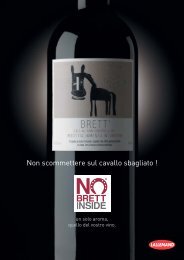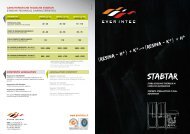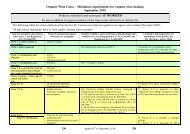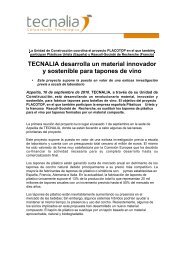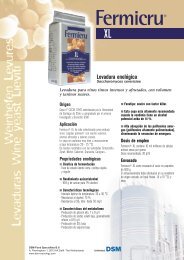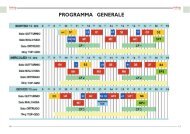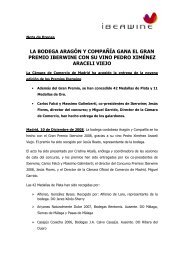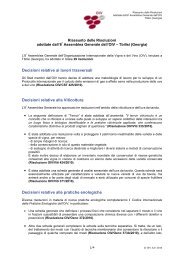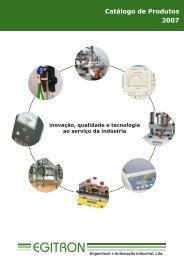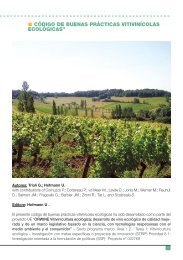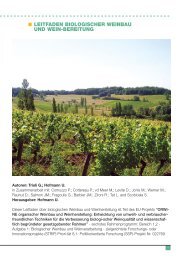Codice di buone pratiche per la viticoltura e l'enologia ... - Infowine
Codice di buone pratiche per la viticoltura e l'enologia ... - Infowine
Codice di buone pratiche per la viticoltura e l'enologia ... - Infowine
You also want an ePaper? Increase the reach of your titles
YUMPU automatically turns print PDFs into web optimized ePapers that Google loves.
122<br />
2.2.3.3. Gestione del<strong>la</strong> macerazione<br />
Principi<br />
La <strong>la</strong>vorazione delle uve <strong>per</strong> <strong>la</strong> produzione <strong>di</strong> alcuni tipi <strong>di</strong> vini può trarre vantaggio dall’uso <strong>di</strong> enzimi<br />
pectolitici con alte <strong>per</strong>centuali <strong>di</strong> cellu<strong>la</strong>si, emicellu<strong>la</strong>si, lipasi e proteasi. Questa tecnica può accelerare<br />
<strong>la</strong> liberazione del colore e dei tannini dalle bucce e consentire una breve macerazione con una<br />
migliore estrazione delle sostanze desiderate. Questi enzimi sono utilizzati principalmente <strong>per</strong><br />
aumentare l’intensità del colore nei vini giovani o <strong>per</strong> ottenere un vino con tannini morbi<strong>di</strong> e ben<br />
strutturati. L’attività enzimatica <strong>di</strong>pende molto dal<strong>la</strong> tem<strong>per</strong>atura: se si ha una macerazione prefermentativa<br />
a freddo, l’azione degli enzimi risulta essere più lenta ed un eventuale trattamento termico<br />
successivo può <strong>di</strong>sattivarli.<br />
L’anidride solforosa <strong>di</strong>scioglie le sostanze coloranti del<strong>la</strong> buccia nel<strong>la</strong> fase liquida e <strong>la</strong> sua presenza<br />
durante <strong>la</strong> macerazione è desiderata qualora si <strong>la</strong>vorino uve scarsamente ricche <strong>di</strong> sostanze coloranti.<br />
L’alcol e <strong>la</strong> tem<strong>per</strong>atura giocano un ruolo sinergico con <strong>la</strong> SO 2.<br />
Opzioni <strong>di</strong> vinificazione<br />
Enologia a impatto<br />
zero<br />
Le caratteristiche delle<br />
uve ed il tipo <strong>di</strong> vino<br />
da produrre non<br />
richiedono interventi<br />
aggiuntivi in macerazione<br />
Uve pigiate e/o <strong>di</strong>raspate<br />
Controllo del<strong>la</strong> tem<strong>per</strong>atura<br />
Al<strong>la</strong> vasca <strong>di</strong> macerazione<br />
Aggiunte<br />
Necessaria: nessuna<br />
Enologia a basso impatto<br />
Enzimi <strong>di</strong> macerazione<br />
Alle uve pigiate vengono<br />
aggiunti enzimi speciali, <strong>per</strong><br />
accelerare e <strong>per</strong> mo<strong>di</strong>ficare<br />
l’azione estrattiva<br />
Uve pigiate e/o <strong>di</strong>raspate<br />
Aggiunta <strong>di</strong> enzimi (0,5 – 3<br />
g/hL)<br />
Controllo del<strong>la</strong> tem<strong>per</strong>atura<br />
Al<strong>la</strong> vasca <strong>di</strong> macerazione<br />
Necessaria: enzimi<br />
2.2.3.4. Movimento del pigiato<br />
Schede informative:<br />
#: enzimi pectolitici<br />
Documenti<br />
corre<strong>la</strong>ti<br />
Principi<br />
La maggior parte delle uve non raggiungono <strong>la</strong> maturazione completa del<strong>la</strong> buccia e vengono trasformate<br />
quando <strong>la</strong> parte non matura dei grappoli può conferire aromi erbacei e tannini astringenti.<br />
Una rottura meccanica del<strong>la</strong> buccia comporta un’esposizione dei tessuti in essa presenti con una



